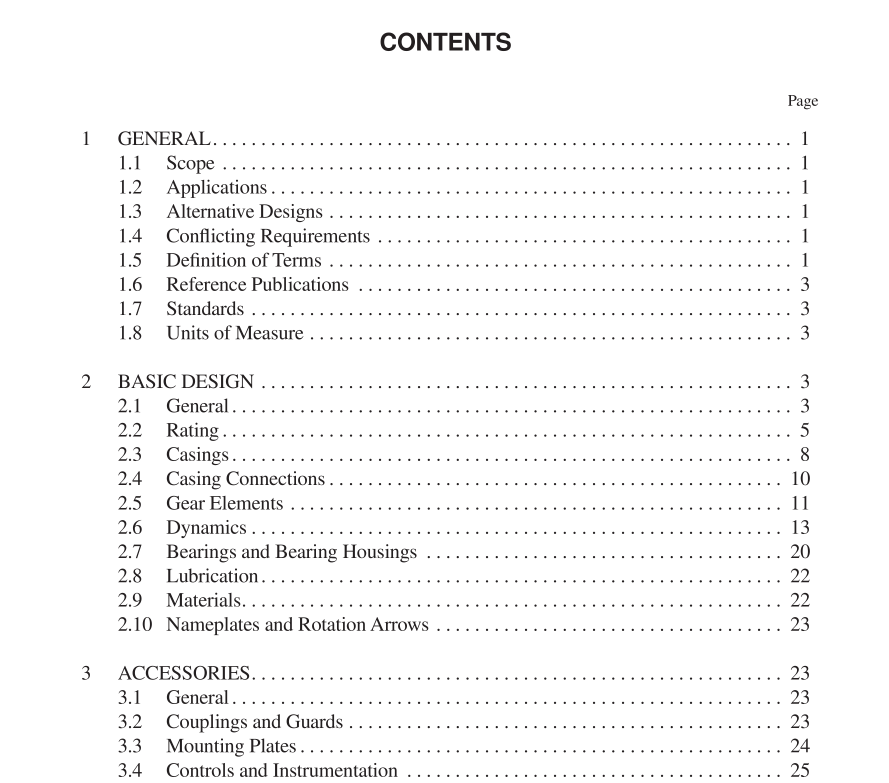API STD 613 pdf download

API STD 613 pdf download.Special Purpose Gear Units for Petroleum, Chemical, and Gas Industry Services
1.5 DEFINITION OF TERMS
1.5.14 maximum allowable speed (in revolutions per minute) is the highest speed at which the manufacturer’s design will permit continuous operation. 1.5.15 maximum continuous speed (in revolutions per minute) is the speed at least equal to 105% of the rated pinion speed for variable-speed units and is the rated pinion speed for constant-speed units. 1.5.16 mechanical rating is the gear unit rated power (see 1.5.9) multiplied by the specified gear service factor (see 1.5.7). 1.5.17 minimum allowable speed (in revolutions per minute) is the lowest speed at which the manufacturer’s design will permit continuous operation. 1.5.18 normal transmitted power is the power at which usual operation is expected and optimum efficiency is desired. The normal transmitted power may be equal to or less than the gear unit rated power. 1.5.19 normative: A requirement of the standard. 1.5.20 observed: An inspection or test where the pur- chaser is notified of the timing of the inspection or test and the inspection or test is performed as scheduled if the pur- chaser or his representative is not present. 1.5.21 owner: The final recipient of the equipment who may delegate another agent as the purchaser of the equipment. 1.5.22 pinion refers to the highest speed rotor. 1.5.23 profile modification: A calculated machined deviation of the pinion and/or the gear wheel tooth flank from the theoretical tooth form. It is intended to obtain a trapezi- form tooth load transfer distributed evenly along the path of contact in a transverse section when the gears are operating at normal load. 1.5.24 purchaser: The agency that issues the purchase order and specification to the vendor. Note: The purchaser may be the owner of the plant in which the equipment is to be installed or the owner’s appointed agent. 1.5.25 The rated input speed of the gear unit (in revolu- tions per minute) is the specified (or nominal) rated speed of its driver, as designated by the purchaser on the data sheets. 1.5.28 scuffing resistance: A measure of the oil films ability to prevent metal to metal contact of the gear set teeth in the mesh during operation. 1.5.29 shall: Used to state a mandatory requirement. 1.5.30 should: Used to state a recommendation. 1.5.31 special purpose application: An application for which the equipment is designed for uninterrupted, con- tinuous operation in critical service, and for which there is usually no spare equipment. 1.5.32 special tool: A tool which is not a commercially available catalog item. 1.5.33 The tooth pitting index ( K ) corresponds to a contact surface stress number. The tooth pitting index is used to determine a load rating at which progressive pitting of the teeth does not occur during their design life. 1.5.34 total indicator reading (TIR), also known as total indicated runout: The difference between the maxi- mum and minimum readings of a dial indicator or similar device, monitoring a face or cylindrical surface during one complete revolution of the monitored surface. Note: For a perfectly cylindrical surface, the indicator reading implies an eccentricity equal to half the reading. For a perfectly flat face, the indicator reading gives an out-of-squareness equal to the reading. If the diameter in question is not perfectly cylindrical or flat interpretation of the meaning of TIR is more complex and may rep- resent ovality or lobing. 1.5.35 trip speed (revolutions per minute) is the speed at which the independent emergency overspeed device operates to shut down a variable-speed prime mover. For the purpose of this standard, the trip speed of alternating current electric motors, except variable frequency drives, is the speed (revolu- tions per minute) corresponding to the synchronous speed at maximum supply frequency.









